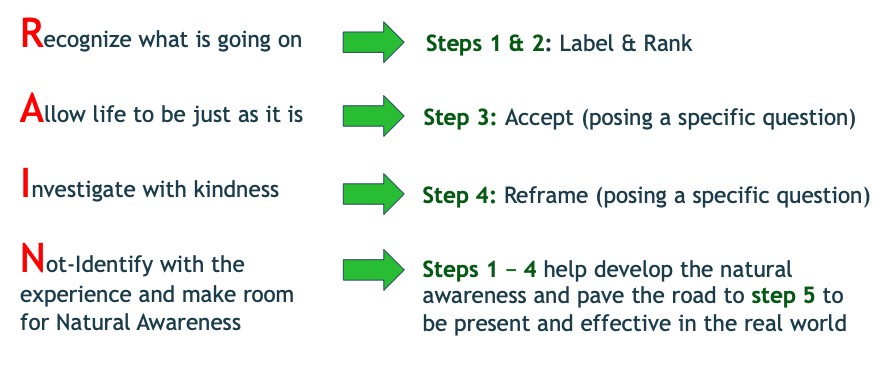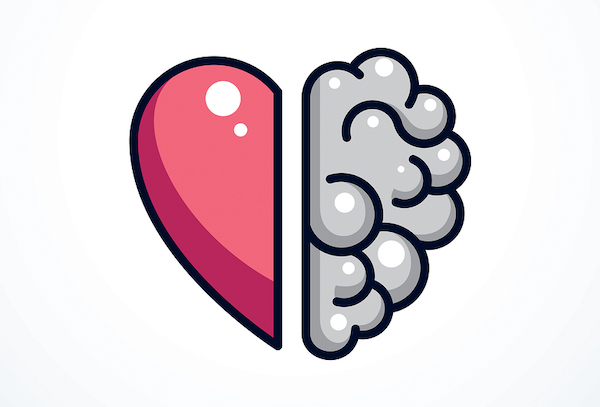“Feeling overwhelmed? Remember ‘RAIN,'” wrote Tara Brach, in her article for Mindful.org. RAIN is an ancient Buddhist way to cope with hardship, which is as applicable today as ever before, and which consists of the following four steps:
- Recognize what is going on.
- Allow life to be just as it is.
- Investigate with kindness.
- Not-Identify with the experience and make room for Natural Awareness.
Remembering RAIN, and practicing RAIN in real life, are two very different things. For those who want to unpack the wisdom embedded in RAIN and transform it into specific and digestible techniques that anyone can put into practice, I would like to share with you the Mindfulness @Work 5-Step Formula. This Formula originated as part of our effort to bring mindfulness to the workplace, but as it turned out, it’s equally applicable before, during, and after work. Here are the steps at a glance, followed by an introductory walkthrough, and additional helpful resources:
- Labeling
- Ranking
- Accepting
- Reframing
- Refocusing
1. Labeling
Pause for a mindful moment, acknowledge the emotion, and name the unpleasant emotion–whether it be “Fear,” “Anxiety,” or “Sadness.”
Naming it engages your prefrontal cortex, the part of your brain responsible for critical thinking and problem-solving. And while you are at it, you may come across related thoughts and/or bodily sensations, so why not unpack these too by naming them? Ask yourself “How am I feeling? What am I sensing? What am I thinking?” And preferably, jot these answers down in writing.
2. Ranking
Rank the event that caused the emotion on a scale from 1 to 10, with 1 being the most tragic event that can happen, and 10 being the best and happiest event.
It is important to keep in mind that we are ranking the event, and not how we feel about the event. Below are ranking examples from our workshop participants. There is no “one size that fits all” approach to this. While it can be helpful to compare notes with others, it’s important to come up with your own ranking scale. In addition to engaging the prefrontal cortex further and therefore calming down the nervous system, the ranking helps put things in perspective. While it may feel devastating to hear a critical comment from your colleague or manager, ranking the event is likely to help you calm down, which is a huge step in self-regulation and being able to respond mindfully instead of reacting:

3. Accepting
Pause for another mindful moment and ask: “What would it be like to let this emotion ‘be’ for now and feel it?” Instead of resisting the emotion, trying to fix it, or suppressing it, just let the feeling be and go where it needs to go. This attitude transforms resistance into curiosity and is likely to diminish the grip that the emotion has on us. This also applies to the accompanying thought and/or sensation.
4. Reframing
Ask yourself, “What can I learn from this emotion and this situation or event?” and turn the situation into a learning opportunity. First, you will learn that no matter how bad you feel right now, the feeling will not “kill” you. It is actually manageable, as most daily situations are. Second, you are likely to learn what situations trigger this emotion. Understanding this builds your self-awareness and self-knowledge. It enables you to do deeper work and better understand the beliefs underlying these triggers, which helps address them at the root cause level.
5. Refocusing
Finally, bring your attention back to where you want to be, in the present. If you were working on a task when you experienced the emotion, it is time to go back and refocus on the task. If you are were having a conversation with someone, then that means refocusing on the conversation and being present and effective with your conversationalist.
Ensuring success with mindful meditation
The Mindfulness @Work 5-Step Formula results ranged from feeling a bit better to experiencing an “aha moment” accompanied by significant relief. One way to ensure success is the practice of mindfulness meditation, which can sharpen the self-awareness and self-regulation skills. This enables our nervous system to navigate through the emotions, thoughts, and sensations, like never before. Here is a mindfulness meditation practice which includes kindness to oneself, an important aspect in the success of RAIN and the Mindfulness @Work 5-Step Formula.
In summary here is how the Mindfulness @Work 5-Step Formula can help you put RAIN into action:

Related notes and links to other articles
Need help practicing the Mindfulness @Work 5-Step Formula?
Learn more about the 21 Practices for Happiness @Work eCourse, Workshop, or Webinar, where this formula and 20 other practices are presented including tools to help you with your productivity, wellbeing, and skill development.
Articles on “RAIN”:
Feeling Overwhelmed? Remember ”RAIN”: https://www.mindful.org/tara-brach-rain-mindfulness-practice/
Ancient Buddhist Way to Cope With Hardship: https://www.yogajournal.com/yoga-101/let-it-rain

